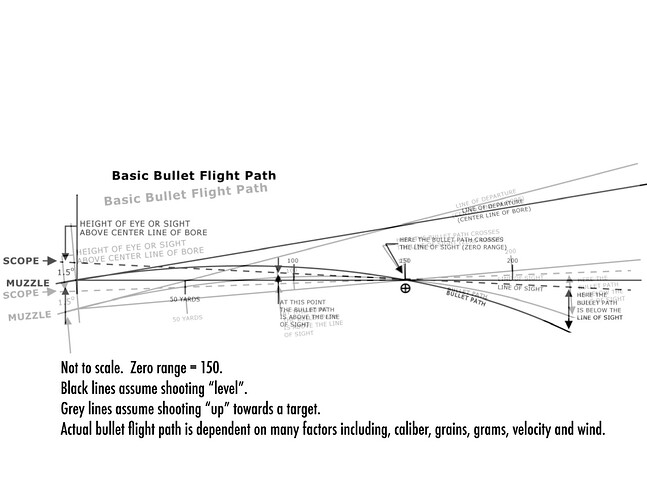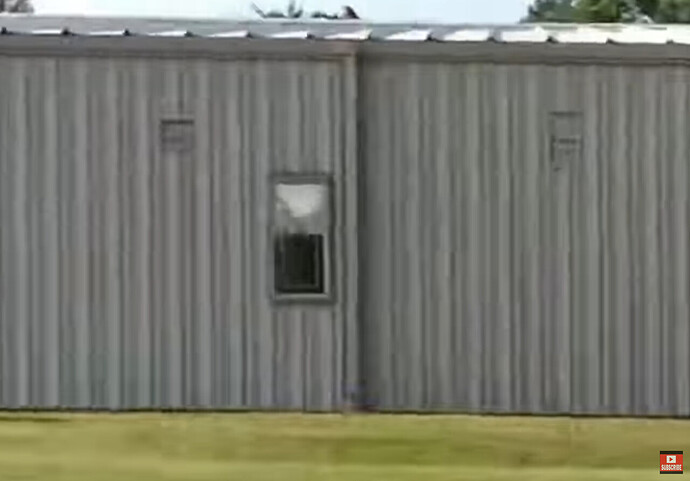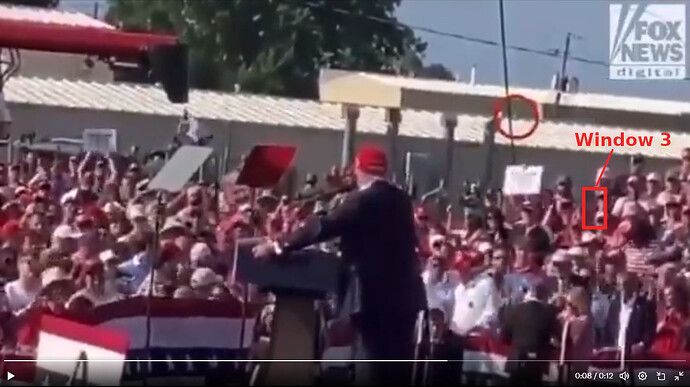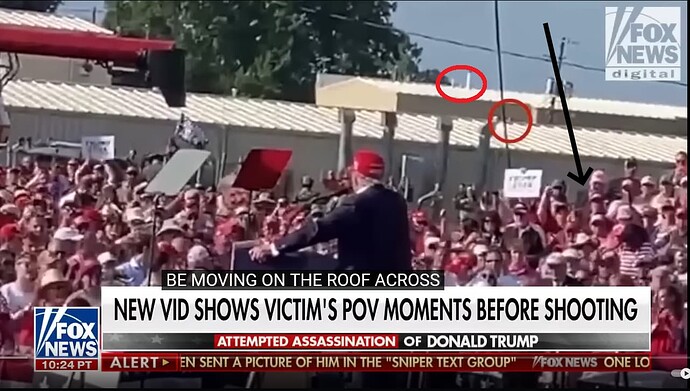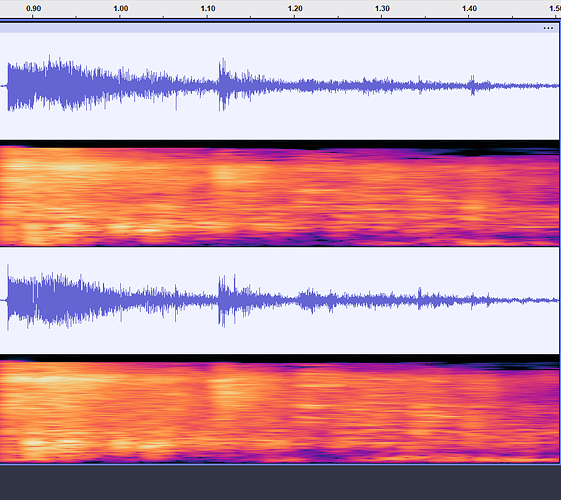I didn’t propose to use the sonic crack as an absolute time marker, but to use the location-dependent phase shift of the amplified crack wrt Trump’s mic reference as a filter criterion to accept or reject the supposed location of the camera/microphone. All this does not depend on the true velocity of the projectile, if Juan Rur’s view proves to be correct. But his claim itself is testable, if a decent number of audio files with nominal mic locations was available.
Tell me if I understand you right. At Trumps mic we hear a sonic crack (CT) and a gun report (RT). At some different mic we hear the amplified CT which now had to travel from the loudspeaker to this new mic, let’s call that Cm, and the gun report (Rm) which travelled from the shooter to this mic. And then we compare RT-CT to Rm-Cm and use this to validate an audio file + location.
Correct?
tool like this might help.
Yeah sorry my bad. At the time of posting I thought they were telling us it was the first shot. Thanks man
Best ignore that data. I’ve already replaced it. Those were my best guesses at the time. Also, we need to use more than just one shot. Every point has an error. (Mic might have moved, recording errors, wind, etc.) If we look at single data points then it may be misleading. So we need to analyze as much data as possible. It’s like doing physics experiments in school. Get as many data points, estimate error, plot the trendline then see how badly we messed up. Then reiterate. That little webpage I made wasn’t meant as a solution, just to be part of the process. More of a communication tool at this point.
The alleged shooter apparently used a standard off the shelf DPMS AR15. That’s a $800 rifle approximately. Fully auto AR15 or M16 is around $50,000 or effectively very very expensive, would not have likely been owned or used by a middle class family or allowed his son access to it to take it to the range given the value, scarcity, and restrictions.
Questions about “cyclic rate” are odd and irrelevant. Those 8 shots are well within the capability of any semi-auto weapon ever made.
I didn’t have to “look up” anything. This is information I simply know.
Concerning bullet paths…
Here is a simplified drawing.
The assumption is that the scope on the gun (that shot President Trump) was zeroed to 150 yards (or 12.75ft closer than Crooks was). Zeroed meaning that if the cross hairs were on a target at 150yards (or whatever it was zeroed to), in zero wind, the bullet will hit that target. It won’t matter if you are shooting slightly uphill.
When shooting level, or uphill, the bullet will eventually fly over what is in view in the scope. In actuality, there is a certain range that people’s heads, fences, other obstructions can be visible in the scope and possibly obscuring the view of the scope, but the objects in the scopes’ view won’t be hit by the bullet. If the bullet is granted enough distance to descend to the target, then the bullet will hit the target.
The sniper probably could have hit the side of the target’s head at any time. I know that there were many law enforcement officers surrounding Crooks position, but the sniper may have been waiting until President Trump was looking directly at the sniper so the sniper could hit President Trump directly between the eyes. (What a terrible thought, yet it may be a factor in President Trump surviving the shooting.)
Also note that if one is shooting up hill on the gray path on the picture, then the bullet actually stays “higher” for longer after the target.
Great work with the audio analysis.
In the cad program, I would suggest using a curved line for the bullet arc, instead of a straight line which is what the scope would see.
Just uploaded my new code.
https://drive.google.com/drive/folders/1-Qo1EsAV_c7gTZOQO8yWveeICGKAYwEd?usp=drive_link
It includes your analysis as well as TOA. (The video files are uploading right now, but it will be a few min before they finish.)
The code’s a bit messy though, so don’t hold it against me.
One may think that one would plan for such contingencies?
How does one quickly adjust for a failed missed shot?
(See earlier post about bullet flight paths)
Reset, keep same elevation and make a slight wind correction? But the target may have moved….
Often times people duck when bullets start flying…
Reset, put in a slight wind correction, and then adjust lower (towards center mass of target)?
A result of adjusting lower means instead of bullets just wizzing over people’s heads, bullets will be flying in between people and physically though people…
I guess to some people it is worth the price, the term for it called collateral damage.
How does one plan for one shot, one kill?
I am reminded that if a magician does not want to be caught performing a trick, then the magician may need to create a distraction.
A suggestion for the cad drawing.
Using “Trumps mic” as the center, draw a circle where Crooks is, then using that same center, draw a circle 12.75ft closer to “Trumps mic.”
Then see where the possible locations are.
One such possible location may be the back of the room, in the building, directly below Crooks, the room with the window next to the downspout.
When practically lined up between that window and President Trump, (see the angle of the roof) that is the room that produced the screenshot with the black holes visible in the lower part of the window.
Here is the screenshot again.
As explained earlier, one picture is a duplicate copy, so these are the exact same screenshot.
I’d submit those are imperfections in the glass, light reflections, and nothing more.
Why?
- No open window or broken glass was reported or observed by a single spectator or LEO and there were dozens standing there, immediately before, during and after, all windows on near constant video record(s). Two LEOS literally walked up to each window a minute after the shooting, inspected the windows, and looked inside them. There is also a flashlight (presumably) shining out from the inside after the shooting, most probable answer is cops searching dark rooms.
Literally no time/ability for someone to open a window, set up 3 shots, go unnoticed, close window, scurry off. Zero time for that. And since there was no broken glass anywhere, it essentially rules out that theory.
But let’s go further.
-
Those windows are perhaps 6’ tall, so those holes are perhaps 2-3’ apart. Bullet’s fired with a 2’ spread would be a hundred feet apart at 150 yards. That is not the evidence of a carefully aiming professional sniper.
-
Obstacles in the way. That building sits in a depression, several feet down. Between the lower part of that window and the Trump diaz was a 6 to 8’ tall chain link fence, meandering people (witnesses, obstacles), and bleachers filled with people, and other random clutter. Even Crooks apparently hit and killed someone in the bleachers between him and Trump and Crooks was probably 10’ higher elevation than the windows.
In summary, I don’t see any reasonable 1st floor angle a professional would opt for, too many obstacles, nobody witnesses any open or broken windows.
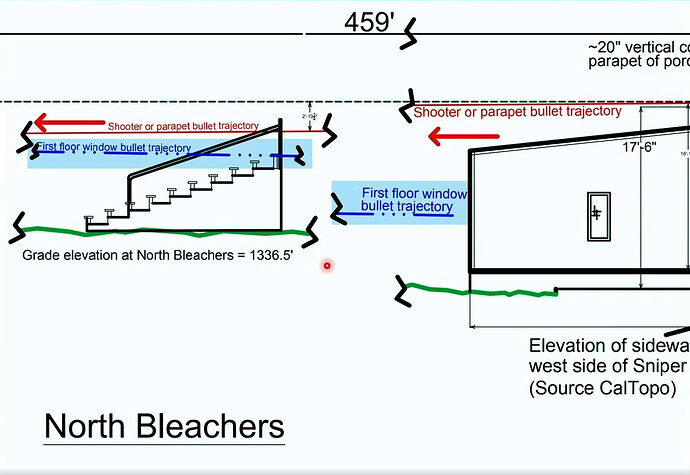
I’ll direct your attention to the tall building roof behind Crooks and ongoing discussion about it as it makes far more sense in all regards.
If time synchronisation is not achieved by shifting Cm to CT, then the first method should test if the following expression is true for any candidate mic m:
CT-Cm - f(pm, pL1, pL2, Vs) < e
with
CT sonic crack at Trumps mic
Cm sonic crack at a field mic
pm coordinates of the field mic
pL1,2 coordinates of the loudspeakers
Vs theoretical value of the speed of sound that day
e some reasonable error estimate
and
f(pm, pL1, pL2, Vs) = min(abs(edist3D(pm,pL1)), abs(edist3D(pm,pL2))) / Vs
edist3D is meant as a call to a function returning the euclidian distance in 3D space. My guess is that the center of the speaker box is roughly 25 m above ground, which is significant in this context.
Continuing with your notation
RT gun report at Trumps mic
Rm gun report at a field mic
and your approach
compare RT-CT to Rm-Cm and use this to validate an audio file + location
I just don’t fully understand it, at least today. In any case, all depends on the statistics of the first test. Does the field mic data set confirm the hypothesis that dist3d(CT, Cm) is proportional to CT-Cm? Then all Cm are in reality equal to CT and the sonic crack produced by the supposedly used AR-15 would be really quiet at some distance.
Yet it might also be insightful to raise the question why there is only a sharp crackling sound heard from the LEO and/or SS shooter(s).
It appears that the audio analysis supports two separate shooter towards President Trump.
One shooter was obvious, because he ended up dead on a rooftop.
The other shooter appears to be in the category of sniper by definition, because they were pretty accurate (actually hitting President Trump), and they appear to be hiding. Some snipers get creative with their hiding.
Snipers can work alone, and snipers (usually military or government trained) can work as two man teams (one on the scope and one on the gun).
Here is a link to a post I did in “Audio & Video …”
I made an interactive graphic on Desmos where you can see the locus of points where a second shooter might be, provided you have a second microphone of fixed and known location; just by measuring the time gaps between, say shots 3 and 4 (or shots 8 and 9) on recordings from different microphones. And provided one sound source location is known.
Should be able to identify location of shots 10, 9, and if 123 vs 45678 are different locations. If you have more than 3 recordings (from different places), should be able to triangulate and get a fairly accurate spot.
my initial assessment was the one on the left is photocopied, i don’t think they changed his face i think they removed something. the curvature of the ear appears to be wrong, after about 15 minutes i lost entrist since the bullets are infinitely more traceable. Hope that helps
im not asking you to look anything up. you volunteered your opinion. i have the information on the cyclic rate; you need not trouble yourself.
Hi @cmartenson
Saw your video today. It was a good video. I had the same idea, a shooter under the roof, but don’t know what the interior is like. If it’s an open ceiling then… The reason I thought this was from DJStew’s video. Look at the first 3 shots then the next 5.
First 3 shots have a faint echo. It starts with a sonic boom then about 0.03 seconds later there’s the muzzle blast. It’s faint and hard to spot. About 0.213 seconds after that, there’s an echo but it’s faint. What’s significant is the volume along with the spectrogram.
For an echo, you expect lower frequencies to come through better than higher frequencies. The higher the frequency the more quickly it’s absorbed. I can think of but one reason for this: The sound passed through a small opening. When sound passes through a small opening, higher frequencies pass right through. Lower frequencies will diffract more, which means they spread out. That leaves less energy to reach DJStew.
The echo is about 0.21 seconds, which is about 70m. The width of building 6 is about 25m. So the echo of the muzzle blast would bounce off the far wall, reach the shooter (50m) then about 20m down to DJStew. So that’s the only reflective surface that lines up.
The next 5 shots have no echo. When the video first came out, it really stood out to me. I guess now there’s two strong data points that support a shooter in the attic hypothosis.
Edit: Brain fart. Ignore the 20m distance down to DJStew. Both sounds traveled that distance. 50m or 70m is within the error range.
It’s been a long time since I looked into sonic cracks. IIRC, every time a super sonic bullet passes a fixed object there is a crack. IE, if a bullet passes a tree in it’s line of filght, there is a sonic crack at that location.
From the moment I saw the flashes in the window of the Stewart video, I thought it was likely a LEO checking the room after shots were fired. Very logical explanation. It just dawned on me that he might have done so due to hearing a shot from that vicinity, such as one from the ceiling crawl space. Just one more possible data point to support that theory if that’s what the flashes were.
I watched John Cullen on the “Coffee and a Mike” Show on Rumble from 7/30/2024
He said he took the Dave Stewart video, slowed it down to 1/10 speed and put through an audio processor. He finds something like 10 or more subsonic, suppressed rounds fired before the audible Shot #1 as we have been calling it was ever fired. He believes these came from multiple locations including a first floor window of Building 6, a sniper in a tree, probably another in another tree, and one on the water tower. The first shots were fired at both CS teams on the cow barns. He believes a shot from the South cow barn (silenced) took out Crooks: a few frames show a bullet on 2 consecutive frames speeding in the direction of Crooks. He believes Crooks was dead before Shot #1 was fired.
The theory is that the shooter in the first floor window realizing that Crooks was dead, switched to an AR 15 and took shots 1,2,3. He says the crack-boom of .22 seconds correlates with the front edge of building 6 rather than the center of the roof. By the way, .22 seconds vs .212 seconds is a difference of 16 feet, suggesting 45678 may have come from one of the trees.
After Trump stood back up, more subsonic suppressed rounds were being fired.
He says a shot from the secret counter sniper location killed the sniper that was on the water tower - this was a 488 yard shot.
He also posits that the person firing multiple subsonic suppressed rounds from a 1st floor window, then an AR15 for shots 1,2,3 and then possibly more subsonic rounds may have cut his hand on broken glass while picking his brass, put his weapons away, went to the bathroom to clean up his bloody hand and then made up a story about climbing up to the metal roof and having the shooter point his gun at him. In other words, the shot that hit Trump’s ear was fired by someone wearing some kind of uniform. There was someone in the AGR building wearing Secret Service insignia.
This explains the CS teams on the cow barns flinching and reacting, there is also some footage showing the North barn team counter sniper changing his position to the right by 20 or 30 degrees apparently targeting the trees.
Crooks may have believed the snipers would be all taken out before he started shooting.
As to why the subsonic rounds all missed: he suggest the rounds would be 4 times the weight of an AR 15 round and going only 900 ft/sec so more susceptible to wind. He also thinks some of the injuries to civilians may have been from the various snipers on water tower or trees.
There is also a short video on youtube with multiple screens synced up:
John Cullen again. If you go to 5:13 in that video, you’ll see something happening with a curtain moving in a first floor window of building 6 (2nd from the right).
